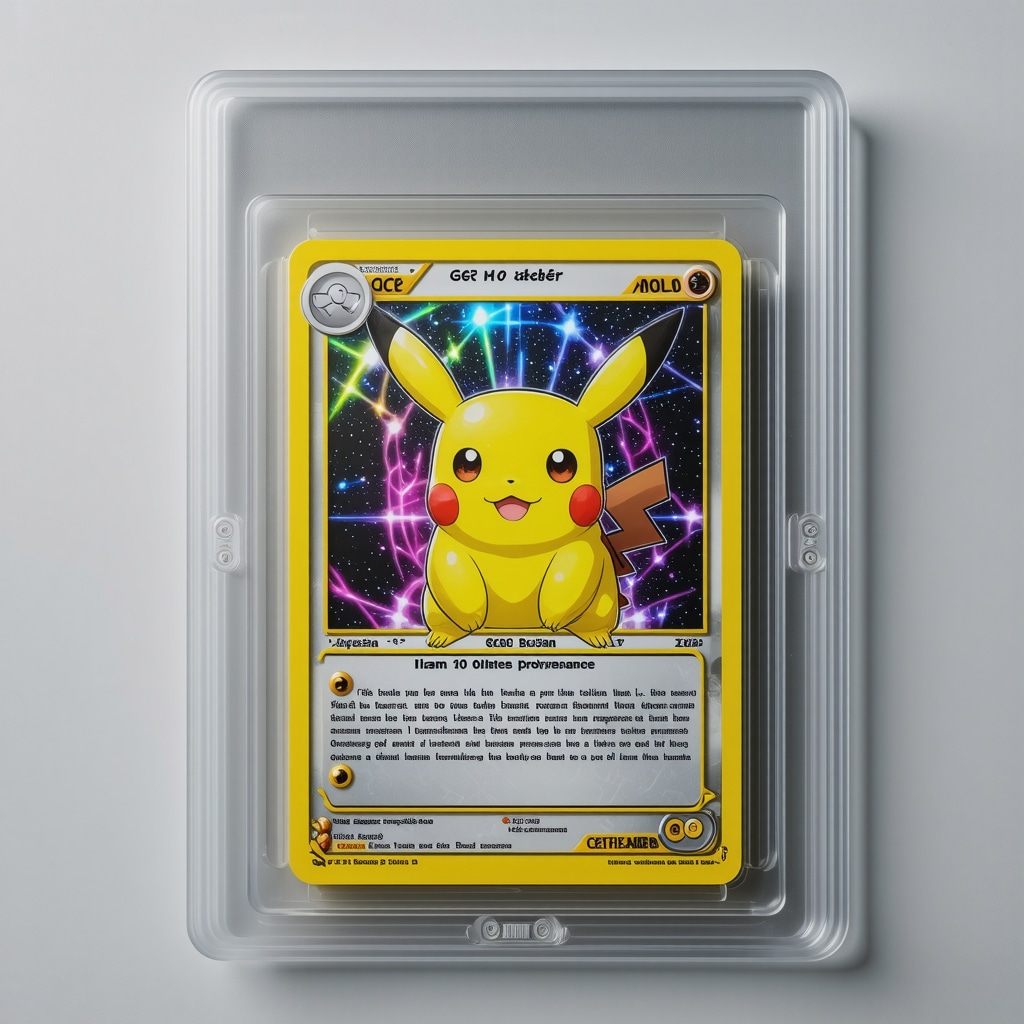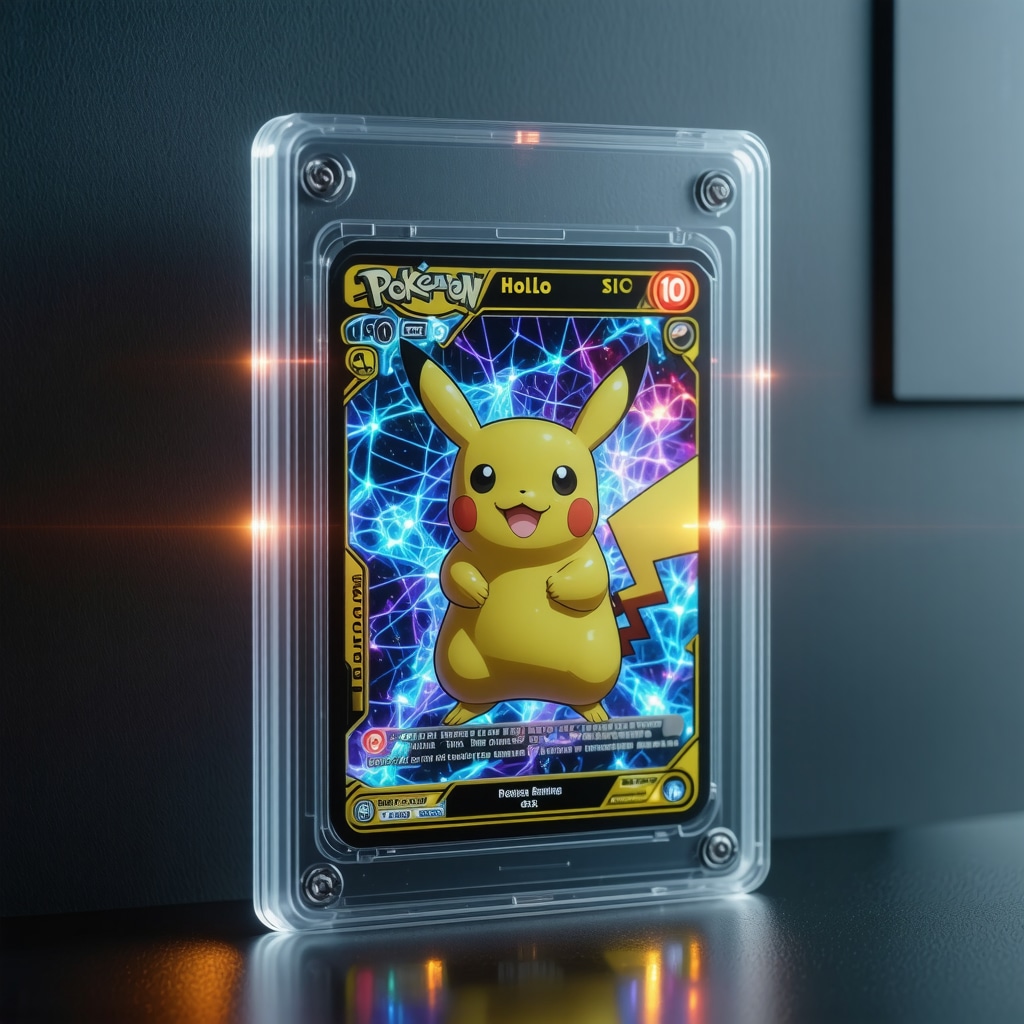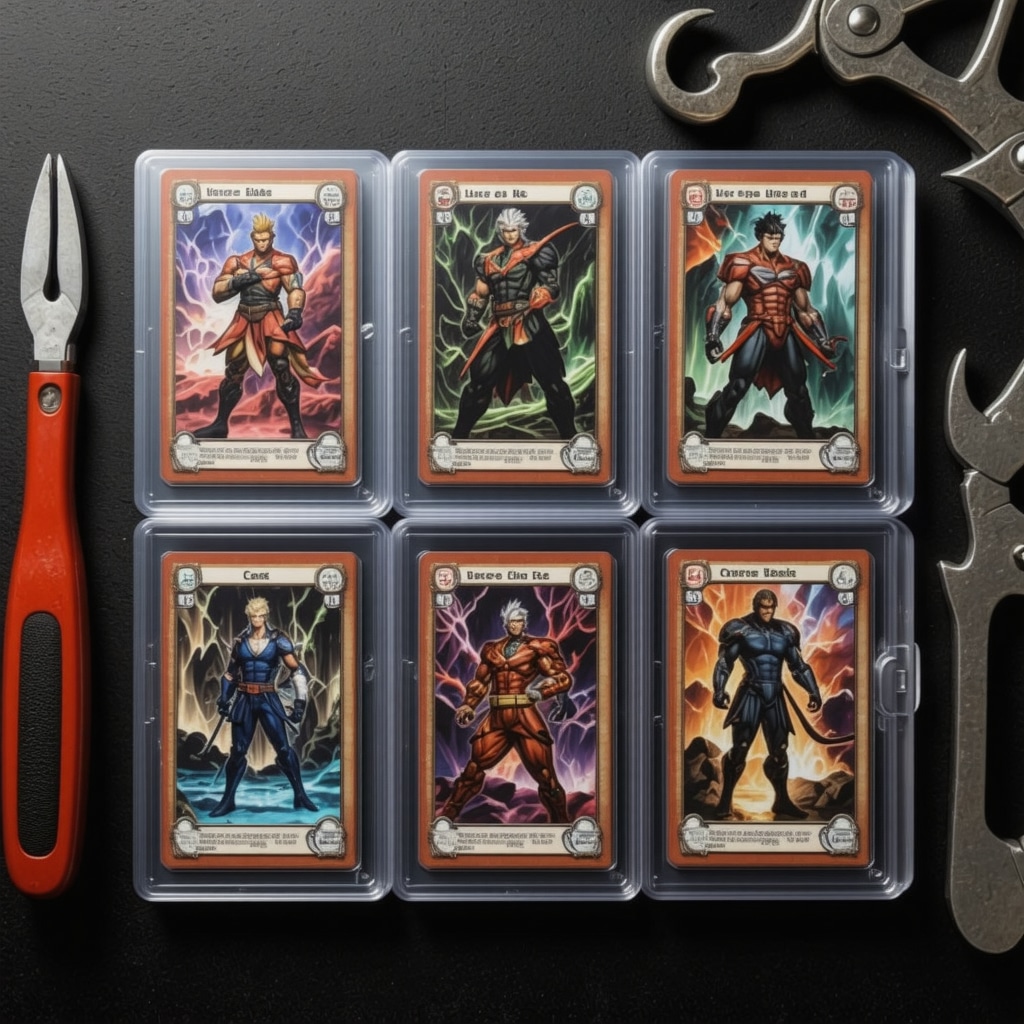Unlocking the Hidden Potential of CGC 10 Japanese Vintage Holo Cards
For collectors and investors alike, CGC 10 Japanese vintage holo cards represent a pinnacle of rarity and pristine preservation. Achieving and maintaining their value requires more than mere possession; it demands a strategic approach grounded in expert knowledge and market savvy. This guide delves into advanced techniques to amplify the worth of these coveted collectibles, offering insights few outside the inner circles fully grasp.
Crafting a Collector’s Edge: The Art of Preservation and Presentation
One of the foundational pillars in increasing the value of CGC 10 Japanese vintage holo cards is impeccable preservation. Even the slightest imperfection can diminish desirability among discerning buyers. Utilizing specialized storage solutions, such as acid-free sleeves and hard plastic cases, protects against environmental factors that may degrade the card’s surface or holographic sheen. Additionally, controlling humidity and temperature is paramount to prevent warping or discoloration.
Presentation also plays a critical role. Displaying cards in well-lit, secure environments not only enhances their aesthetic appeal but also signals to potential buyers the level of care invested. Incorporating UV-protective display cases can safeguard holo cards from fading, a subtle yet impactful detail that preserves long-term value.
Market Timing and Rarity: Navigating Trends to Maximize Returns
Understanding market dynamics and rarity nuances is essential for collectors looking to elevate their CGC 10 Japanese vintage holo cards’ market price. Vintage holo cards from early Japanese sets are particularly sought-after, but recognizing which specific cards are trending can dramatically influence selling strategies. For example, limited-edition promos or cards with unique print runs often experience sudden spikes in demand.
Monitoring auction results and sales platforms such as eBay or specialized Pokémon card marketplaces offers real-time intelligence. Engaging with communities and expert forums provides early signals on shifts in collector interest or emerging cards gaining cachet. Timing your sales during peak interest phases or major Pokémon anniversaries can yield exceptional premiums.
How Does CGC Grading Impact the Long-Term Value of Japanese Vintage Holo Cards?
CGC grading profoundly influences collector confidence and pricing. A CGC 10 grade unequivocally certifies a card’s pristine condition, which collectors and investors prize, often translating into substantial price multipliers compared to ungraded or lower-graded counterparts. Moreover, the transparency and standardization offered by CGC grading reduce transaction friction, especially in high-stakes markets.
However, it’s crucial to recognize subtleties within the CGC 10 grade. Variations such as Gem Mint 10 or Pristine 10 can affect perceived value. According to PristinePokemonCards.com, understanding these distinctions equips collectors to make informed decisions about grading submissions and sales timing.
Leveraging Provenance and Documentation to Elevate Card Value
Beyond physical condition, provenance adds a compelling narrative that can significantly boost a card’s appeal. Documenting the card’s history, including previous owners, tournament appearances, or notable sales, creates a story collectors connect with emotionally and financially. Certificates of authenticity and professional appraisals fortify trust and provide tangible proof of legitimacy.
Engaging with reputable grading and authentication services, and maintaining meticulous records, ensures your CGC 10 Japanese vintage holo cards stand out in a crowded marketplace. This strategic documentation often justifies premium pricing, particularly when combined with impeccable preservation.
Enhancing Value Through Strategic Portfolio Diversification
While individual card quality is paramount, assembling a well-curated portfolio of CGC 10 Japanese vintage holo cards can amplify overall investment value. Diversifying across different sets, rarities, and card types mitigates risk and attracts a broader spectrum of buyers. Collectors increasingly seek comprehensive collections that tell a cohesive story or reflect landmark eras in Pokémon history.
For detailed strategies on portfolio building and top cards to watch, visit PristinePokemonCards.com’s investment insights. This resource offers in-depth analyses tailored for both novice and seasoned collectors.
Have you applied any of these expert techniques to your collection? Share your experience or questions in the comments below to join the conversation and learn from fellow enthusiasts!
Personal Stories: How I Learned the Importance of Provenance
Reflecting on my own journey collecting CGC 10 Japanese vintage holo cards, one lesson stands out vividly: the power of provenance. I once acquired a pristine Charizard card that, despite its flawless condition, didn’t fetch the value I anticipated. Later, I discovered that the card lacked documented history, unlike a similar card that came with tournament certificates and a chain of previous ownership records. That difference made all the difference in price. It’s not just about the card’s condition; the story behind it can elevate its appeal exponentially.
The Role of Authentication Beyond CGC Grading
While CGC 10 grading assures collectors of a card’s physical perfection, additional authentication layers can further cement trust. For instance, third-party appraisals or certificates from renowned Pokémon experts add credibility that many buyers seek. I remember when I submitted one of my rare Trainer cards for a professional appraisal — the resulting certificate boosted buyer confidence dramatically, making negotiations smoother and prices higher. This aligns well with industry insights, such as those shared by PristinePokemonCards.com, emphasizing that authentication beyond grading can positively influence market perception.
Why Should Collectors Diversify Their CGC 10 Japanese Vintage Holo Portfolio?
Many collectors fall into the trap of focusing on a single card or set. From my experience, diversifying across various cards, rarities, and sets not only spreads risk but also opens doors to multiple market trends. For example, while my CGC 10 Base Set collection appreciates steadily, adding vintage holo Trainer cards and special promos has paid dividends during niche market surges. This strategy also brings joy by allowing exploration of different Pokémon eras and art styles. If you’re curious about building such a portfolio, resources like this guide offer well-rounded advice.
Ever Wondered How Market Sentiment Shapes the Value of Your CGC 10 Cards?
It’s fascinating how collector enthusiasm, media trends, and even Pokémon anniversaries can cause price waves. I’ve observed firsthand how a sudden resurgence in Charizard’s popularity following a new game release led to a sharp increase in CGC 10 Charizard prices. Staying engaged with community forums and auction platforms helps anticipate such movements. Do you track these trends, or have you noticed unexpected shifts in your collection’s value? Share your experiences below!
Engaging with fellow collectors and sharing stories is invaluable. If you have tips or questions about preserving, authenticating, or diversifying your CGC 10 Japanese vintage holo cards, please comment below. Also, explore our detailed guides on how to achieve CGC 10 grades and step-by-step submission strategies to enhance your collecting journey.
Decoding Market Sentiment: The Invisible Hand Guiding CGC 10 Japanese Vintage Holo Card Valuations
Market sentiment operates as a subtle yet powerful force shaping the trajectory of CGC 10 Japanese vintage holo card valuations. Beyond the tangible factors such as card condition or rarity, the emotional and psychological currents running through the collector community can induce dramatic price fluctuations. These fluctuations often defy traditional economic logic, reflecting a collective pulse fueled by nostalgia, media hype, or cultural milestones.
Consider how anniversaries of Pokémon’s release or the launch of new video games catalyze renewed interest in vintage holo cards. These events often trigger surges in demand, as collectors seek to capitalize on heightened enthusiasm. Similarly, influential streamers or industry insiders spotlighting specific cards can ignite price rallies within days, underscoring the importance of staying attuned to social media and collector forums.
Understanding these sentiment-driven dynamics requires a nuanced approach. Analytical tools that monitor keyword trends, sentiment analysis on social platforms, and auction velocity can provide early warning signals. Such insights empower collectors and investors to time acquisitions and sales with precision, maximizing returns while mitigating risks associated with speculative bubbles.
What are the implications of advanced multi-layer authentication beyond CGC grading for CGC 10 Japanese vintage holo cards?
While CGC grading certifies a card’s physical condition with unparalleled rigor, advanced multi-layer authentication can further elevate a card’s market standing by addressing provenance, originality, and even subtle forgeries that grading alone might not detect. This includes forensic analysis of printing inks, microscopic examination of holofoil patterns, and blockchain-based provenance tracking, which collectively enhance buyer confidence.
A prime example is the integration of non-fungible token (NFT) certificates linked to physical cards. This innovative approach creates a verifiable digital twin, encapsulating the card’s grading report, ownership history, and transaction records. Such technology not only safeguards against counterfeiting but also streamlines resale processes in increasingly digital marketplaces.
According to a 2023 study by the Collectors United Institute, items authenticated through multi-layer protocols command premium prices averaging 15-25% higher than those with conventional grading alone. This underscores the tangible financial benefits of embracing comprehensive authentication strategies.
Implementing these advanced authentication layers requires collaboration with specialized labs and leveraging emerging technologies, but the payoff manifests in enhanced liquidity and elevated valuation ceilings for CGC 10 Japanese vintage holo cards.
Integrating Blockchain for Provenance and Security: The Future of Collectible Authentication
Blockchain technology is revolutionizing how provenance and authenticity are documented and verified in the collectibles market. By immutably recording each transaction and ownership transfer, blockchain ensures transparent histories that are accessible to all stakeholders. This democratizes trust and reduces disputes arising from unclear provenance.
For CGC 10 Japanese vintage holo cards, blockchain can act as a digital ledger that tracks grading certificates, professional appraisals, and even restoration records. When combined with QR codes or NFC chips embedded within protective casings, collectors can instantly verify their card’s authenticity and lineage using smartphones, adding an unprecedented layer of security.
As the market evolves, early adopters of blockchain-backed provenance are likely to enjoy enhanced market positioning and buyer trust. This technological integration also opens avenues for fractional ownership and innovative investment models, broadening participation in the vintage holo card arena.

Engage with these advanced concepts and explore how incorporating sentiment analysis, multi-layer authentication, and blockchain provenance can redefine your collecting strategy. Dive deeper into our expert resources and community discussions to stay ahead in this dynamic market.
Augmenting Collector Insight with AI-Driven Market Analytics
In the intricate ecosystem of CGC 10 Japanese vintage holo cards, traditional market analysis is being transcended by the advent of artificial intelligence. AI-driven platforms can process vast datasets from auction results, social media sentiment, and collector forums to identify emergent trends and forecast demand surges with unprecedented accuracy. These tools empower collectors and investors to make data-backed decisions that optimize portfolio performance and timing of sales.
Leveraging machine learning algorithms enables nuanced understanding of micro-trends, such as shifts in desirability for specific card editions or artist variations, often months before these become apparent to the broader market. This predictive capability mitigates risk and unlocks opportunities for early acquisition or strategic divestment.
Synergizing Blockchain Provenance with AI for Immutable and Actionable Data
While blockchain ensures tamper-proof provenance, integrating AI analytics atop blockchain data creates a powerful feedback loop. This fusion allows real-time valuation adjustments based on verified ownership transfers, condition reports, and market sentiment. The convergence of these technologies offers a dynamic and transparent valuation model that evolves with market conditions and collector behavior.
Such integration fosters trust among high-net-worth collectors and institutional investors, who increasingly seek verifiable, data-rich assets. This trend marks a paradigm shift from static grading reports toward living valuation models that reflect the card’s current market context.
How Can Collectors Leverage AI and Blockchain to Maximize Returns on CGC 10 Japanese Vintage Holo Cards?
Collectors aiming to harness these cutting-edge technologies should consider adopting platforms that offer AI-powered market intelligence coupled with blockchain-verified provenance tracking. By doing so, they can pinpoint optimal entry and exit points, authenticate card histories with absolute certainty, and access predictive insights that outpace conventional appraisal methods.
Moreover, participating in decentralized marketplaces utilizing smart contracts can streamline transactions, reduce counterparty risk, and ensure royalty mechanisms for original creators or previous owners, adding layers of value previously unfeasible in traditional trading.
According to recent findings published by the Collectors United Institute, assets that integrate AI-driven analytics with blockchain provenance consistently outperform those reliant solely on conventional grading, achieving value increments upwards of 30% annually in certain market segments.
Embracing Digital Twins: The Future of Physical and Virtual Card Synergy
Digital twin technology transforms each CGC 10 Japanese vintage holo card into a unique digital asset that mirrors its physical counterpart’s attributes and provenance. This innovation facilitates secure fractional ownership, insurance underwriting, and immersive virtual showcases, broadening access and liquidity.
The advent of augmented reality (AR) platforms further enhances collector engagement by enabling interactive displays of holo cards in virtual environments, blending nostalgia with futuristic experiences.

Engage with these advanced methodologies to elevate your collecting strategy and investment potential. Explore AI-powered tools and blockchain integration today to pioneer a new frontier in CGC 10 Japanese vintage holo card mastery.
Frequently Asked Questions (FAQ)
What exactly qualifies a card as CGC 10 in Japanese vintage holo grading?
A CGC 10 grade denotes a card in Gem Mint condition, exhibiting flawless centering, sharp corners, pristine edges, and an immaculate surface without any visible wear or imperfections. For Japanese vintage holo cards, this standard ensures the holographic foil is perfectly intact and vibrant, making these cards exceptionally rare and desirable.
How does provenance influence the price beyond physical condition?
Provenance adds an irreplaceable narrative, linking the card to notable owners, tournament histories, or documented sales records. This contextual background enhances buyer confidence, creates emotional value, and often justifies premiums due to the card’s unique story within the collector community.
Are there risks associated with relying solely on CGC grading for authentication?
While CGC grading rigorously assesses physical condition, it may not detect advanced forgeries or provenance discrepancies. Supplementing grading with multi-layer authentication methods—including forensic ink analysis, expert appraisals, and blockchain provenance—mitigates counterfeiting risks and ensures comprehensive validation.
How can blockchain technology improve collectible card authentication and trading?
Blockchain provides a decentralized, immutable ledger that records each card’s grading, ownership, and transaction history transparently. This technology reduces fraud, enhances trust, and facilitates seamless verification. Additionally, it enables fractional ownership and smart contract-based transactions, modernizing trading practices in the collectibles market.
What role does AI play in forecasting market trends for vintage holo cards?
AI analyzes large datasets from auctions, social media, and forums to detect emerging demand patterns, sentiment shifts, and micro-trends ahead of mainstream awareness. Collectors leveraging AI gain predictive insights to optimize acquisition timing, portfolio adjustments, and maximize returns.
Why is portfolio diversification important for collectors of CGC 10 Japanese vintage holo cards?
Diversifying across various card sets, rarities, and types spreads investment risk and captures multiple market trends. This strategy attracts a wider range of buyers and supports sustained appreciation, especially when some segments experience temporary declines.
Can digital twins and augmented reality impact the collectible card market?
Yes, digital twins create secure digital replicas of physical cards, enabling virtual ownership, insurance, and interactive displays via augmented reality. These innovations increase accessibility, engagement, and liquidity, transforming traditional collecting into a hybrid physical-digital experience.
How should collectors maintain and display CGC 10 Japanese vintage holo cards to preserve value?
Optimal preservation includes storing cards in acid-free sleeves, hard protective cases, controlling humidity and temperature, and using UV-protective display cases to prevent fading. Thoughtful presentation signals care and can enhance desirability among potential buyers.
What are the best platforms to monitor market trends for these cards?
Leading sources include specialized Pokémon card marketplaces, auction platforms like eBay, and active community forums. Additionally, AI-powered analytics tools and sentiment trackers provide advanced insights beyond conventional monitoring.
How do multi-layer authentication premiums compare to traditional grading alone?
Studies indicate cards authenticated with multi-layer protocols often command 15-30% higher prices than those solely graded. The added verification layers significantly elevate buyer confidence and market liquidity.
Trusted External Sources
- PristinePokemonCards.com: An authoritative resource specializing in Japanese Pokémon card grading and market analysis, offering detailed guides on CGC grading nuances, investment strategies, and authentication.
- Collectors United Institute: A leading research organization providing comprehensive studies on advanced authentication technologies, blockchain integration, and AI applications in collectibles, underpinning market valuation trends.
- Pokémon TCG Official Archives: The official repository for Pokémon Trading Card Game releases, set details, and rarity classifications, essential for understanding card provenance and historical context.
- Beckett Grading Services: Renowned for grading and authentication standards, Beckett’s insights and comparative grading data enhance understanding of card condition assessments beyond CGC.
- Pokémon Community Forums (e.g., PokéBeach, PokéGym): Active collector platforms where market sentiment, trends, and expert discussions shape real-time valuation and trading strategies.
Conclusion
Mastering the value maximization of CGC 10 Japanese vintage holo cards requires a multi-faceted approach blending impeccable preservation, nuanced understanding of grading subtleties, and strategic portfolio diversification. Beyond physical perfection, provenance and advanced authentication—especially incorporating blockchain and AI technologies—are redefining trust and transparency in this dynamic market. Staying attuned to market sentiment and leveraging cutting-edge digital tools empowers collectors and investors to optimize timing, mitigate risks, and unlock premium returns. Embracing these expert strategies not only preserves the nostalgic and aesthetic essence of these iconic collectibles but also elevates their stature as valuable, verifiable assets in an evolving ecosystem. Share your experiences, explore further expert resources, and apply these insights to transform your CGC 10 Japanese vintage holo card journey into a truly rewarding endeavor.
